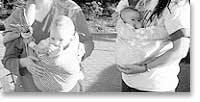Wearing Your Baby and Toddler in a Sling: Helpful Hints Following you will find some tips to (hopefully) help make wearing a sling easier and more comfortable (send your tips to mykidzmommy@hotmail.com): Following you will find some tips to (hopefully) help make wearing a sling easier and more comfortable (send your tips to mykidzmommy@hotmail.com):1. When you first start wearing a sling, try to wear your baby no more than approximately 20 minutes at a time. Eventually you can wear your baby in the sling for long periods of time (some mothers carry their baby all day), but give your muscles a chance to build up first. 2. Use a sling that fits. Most slings come in different sizes. One of the complaints I've heard the most is that the Nojo (tm) sling will not cinch up tight enough. The Nojo (tm) sling is the one commonly found in stores, and it only comes in one size, so it is sometimes too big for smaller moms. If your sling is too big, you may be able to cinch it up tighter even if the padded part seems to prevent you from doing so. Try holding the rings apart wide enough with your fingers so that the padding can be pulled through. 3. Wear your sling as tightly as is comfortable for you and your baby. When baby is close to your body, it's easier on your back and baby feels more secure. 4. Try not to wear the sling below your belly button or waist. If you wear baby too low down, it's hard on your back. Wear baby as high up on your body as is comfortable.
5. You might find that a padded sling is more comfortable than a non-padded sling. Padded slings (such as the Over the Shoulder Baby Holder (tm)) usually have a shoulder pad and padded railings. The padded railings give a cushiony place for babies to rest their head and provide older babies and toddlers with a soft place beneath their legs when they sit in the hip carry. Slings with a shoulder pad can be more comfortable on your shoulder. On the other hand, some mothers prefer non-padded slings. Non-padded slings (such as the Maya wrap (tm)) with loose tails can be easily cinched up tightly. This can help create a small, secure place for tiny newborns to lie in as well as help keep an older baby or toddler firmly on your hip. Also, slings without a shoulder pad can provide greater freedom of movement for the arm the sling rests on. 6. If your sling has a shoulder pad, rest the padding on your shoulder (not your neck. . . I have seen some moms forget to pull it down). 7. Spread out the material that is on your back to help evenly distribute the weight. 8. For slings with a rings and a tail, the top or bottom part of the tail can be pulled independently though the rings in order to get a "custom fit." This is by far the easiest to do with unpadded slings that have a loose tail, but I've found it can be done with padded slings, too. 9. Keep the rings in about the same place you'd wear a corsage. 10. Most mothers have a favorite side to wear the sling. Right handed mothers tend to wear the sling on their right shoulder. Once you get more comfortable wearing your baby in a sling, try switching shoulders sometimes. It helps to give each shoulder a rest and is easier on your back.
|

